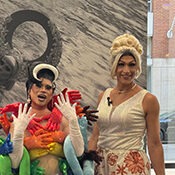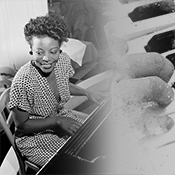
Milwaukee Youth Symphony Orchestra Partners with the MSO to Bring Violins of Hope to Beethoven’s Ninth
David Lewellen
PUBLISHED
Tagged Under: Chorus, Community Engagement, Partners, Violin
The Milwaukee Symphony Orchestra’s next subscription concert will feature music written by a victim of the Holocaust and played on instruments that may have spent time in the concentration camps.
Although the main work on the program is Beethoven’s Symphony No. 9, the first half will feature the slow movement from a string quartet by Pavel Haas, a Czech composer who died in Auschwitz in 1944. And concertmaster Jinwoo Lee will perform on an instrument from the Violins of Hope project, which sends instruments saved from the Holocaust around the world to be played and learned from.
The Milwaukee Youth Symphony Orchestra (MYSO) spearheaded the current Wisconsin residency, which has brought 70 string instruments associated with World War II to the city.
Linda Edelstein, MYSO’s chief executive officer, said that the project “utilizes these instruments as symbols to teach resilience, inspire unity, and educate through concerts and exhibitions. This mission aligns with MYSO’s commitment to nurture, challenge, and inspire, profoundly changing lives and our community for the better, uniting people through the power of music.” MYSO’s performing groups already bring together thousands of students who would never meet each other otherwise, she said, and Violins of Hope is another way to broaden the connection of the arts to the wider community. MYSO is working with more than 60 organizations to offer more than 80 Violins of Hope events, from the Milwaukee area to Eau Claire, La Crosse, Madison, West Bend, Sheboygan, and Racine.
In addition to the quartet performance, the MSO will display several of the instruments in the Ellen & Joe Checota Gallery. Each of the instruments will be accompanied by a story card which will give insights into its history. “Our students and our community will bear witness to the history of the Holocaust through the Violins of Hope and the stories of Jewish musicians who played these instruments,” said Edelstein. “This allows the power of music to unite us today.”
The residency this fall is the culmination of more than two years of effort, during which MYSO raised funds to bring the instruments here and assembled a broad spectrum of community, arts, and cultural groups, as well as schools, universities, and religious organizations to create dozens of events throughout the residency. Edelstein started talking to symphony officials in 2023, well before the 2025-26 season was set.
“Everyone was extremely enthusiastic not just for their own organization, but the community as a whole,” Edelstein said. “We are presenting this residency now because this calling is more important than ever.”
The violins were collected over a period of decades by Israeli luthiers Amnon Weinstein and his son, Avshalom. Following the war, “many survivors found their instruments too painful to keep,” Edelstein said. “But the Weinsteins knew the violins weren’t to blame.”
The instruments represent a wide range of backgrounds and of quality, from family instruments to “some that are excellent and were played by master musicians,” Edelstein said.
Lee said that the violin he will be using has a beautiful sound, but he had to get used to the differences. “The dimensions are completely different from mine,” he said. “It takes time to adjust to a new length, the thickness of the neck, the arch of the bridge.”
The Haas quartet was written in the late 1930s, and Lee said, “I do think it reflects on the events that were about to unfold. There’s a sense of sorrow about it.”
He said of the historic violin, “The sound quality is gorgeous, but it’s more about the symbolic gesture, playing an instrument that survived the concentration camps while the composer didn’t.”
Finding an appropriate work to pair with Beethoven’s symphony of joy and uplift took a lot of thought, according to Bret Dorhout, the MSO’s vice president of artistic planning. “There were a lot of iterations of what would be possible and effective,” he said. He and Music Director Ken-David Masur decided on beginning the symphony program with a quartet in order to showcase the Violins of Hope — a few historic instruments scattered throughout the string section would not have made the same impact.
They considered the factor of “musicians learning difficult music on different instruments,” he said, but sometime this summer — very late by orchestral standards — they decided on the Haas quartet. “It’s beautiful music,” Dorhout said, “but it’s also foreshadowing what was happening in the world.”
“MYSO seeks to create a deeper community connection across the region and state,” Edelstein said. “Violins of Hope – Wisconsin events are an opportunity to redefine the intersection of art, culture, and community.”



